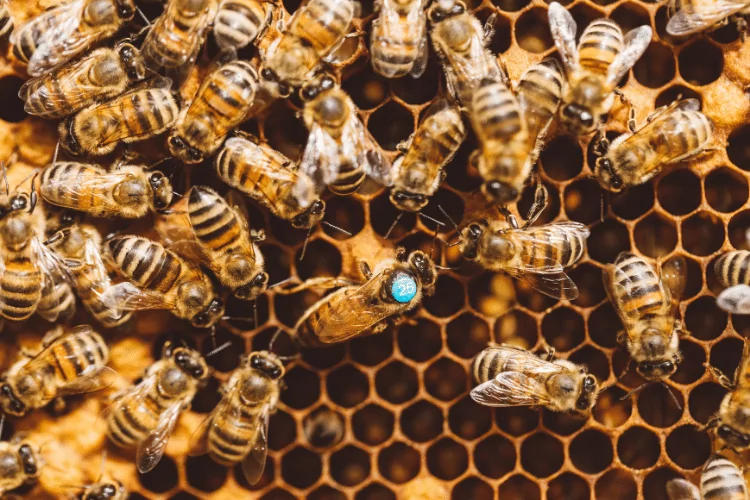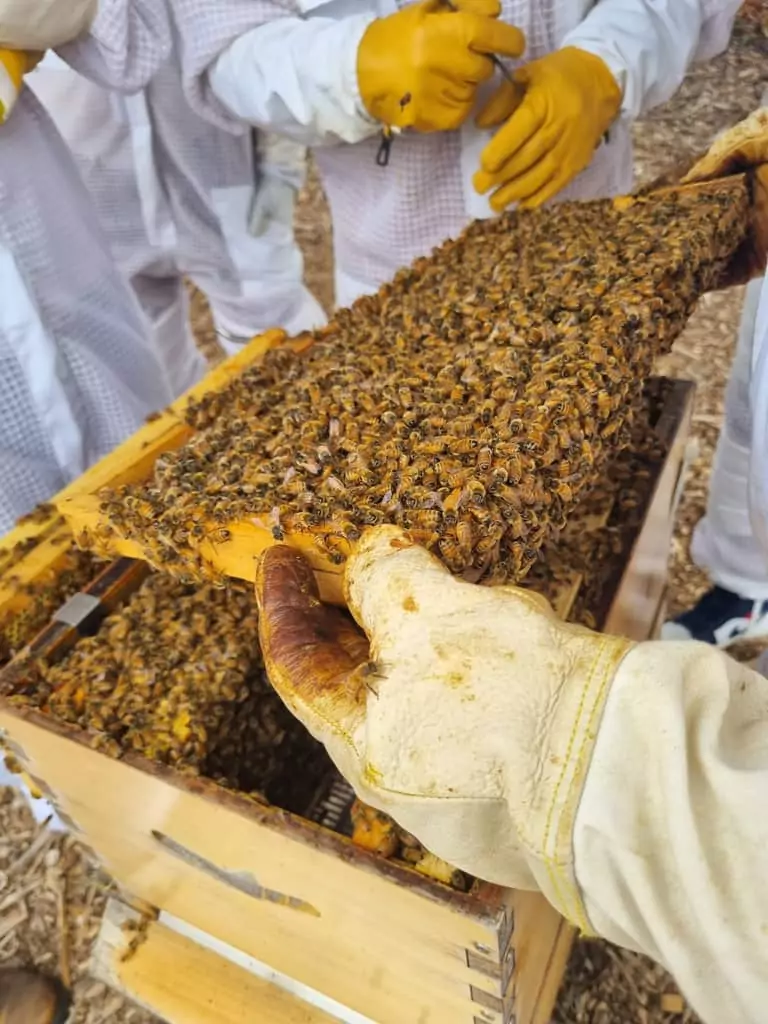With a great temperament and a high honey production rate, Italian bees are almost a standard in the world of beekeeping. But they’re not the only option, and they’re not the most resilient type, either.
A while back, a new player popped into the scene as the quintessential tough guy: the Saskataz hybrid.
So, what’s the deal with the Saskatraz, and how does it compare to the classic Italian bee?
That’s what we set out to find with a conclusive Saskatraz bees vs. Italian bees comparison. Let’s dive right in and see what the fuss is all about!
Saskatraz vs. Italian: Overview
Before we start picking at all the differences between the two breeds, let’s first take a look at the big-picture stuff and consider the history behind each.
| Comparison Point | Saskatraz Bees | Italian Bees |
| Varroa Mites | Tolerant | Susceptible |
| Winterizing | Easy | Challenging |
| Honey Production | High | High |
| Temperament | Gentle | Gentle |
Italian Bees
The Italian Apis mellifera ligustica is, hands down, one of the most popular honey bee species there is.

Once it was introduced from the Apennine Peninsula of Italy to the New World back in 1859, it started stealing the spotlight from the German variety. Today, it’s the number one pick in the United States.
In short, Italian bees are excellent honey producers with an easily identifiable queen (see also: How To Identify A Queen Bee), a moderate tendency to swarm, and a rapid spring build-up.
However, they also have a strong inclination to rob nearby colonies. Plus, they go over honey stores fairly quickly during the winter.
Saskatraz Bees
Saskatraz bees are nowhere near as old as the Italian ones. They were only recently developed from a bunch of bee races (Russian, German, and Canadian) and even some other hybrids, like the Buckfast, with the goal of making productive, gentle, and tolerant bees.
This 2004 hybridization project started in Meadow Ridge’s completely isolated apiaries in Saskatchewan, Canada.
Interestingly, some people believe the project’s setup actually explains the name. After all, it breaks down to “Saska” (short for the Canadian province’s name) and “traz” (a reference to Alcatraz’s remote location).
Keep in mind that isolation was crucial to protecting the gene pool during the selection process.
3 Key Differences Between Saskatraz Bees and Italian Bees
Both types of bees have desirable traits, but there are some core differences in their cold tolerance and disease resistance.
Here are three factors to keep in mind when choosing between classic Italian and hybridized Saskatraz honey bees:
1. Parasitic Mite Tolerance
One of the main drawbacks of keeping Italian bees is that they’re rather susceptible to varroa (Varroa destructor) and tracheal (Acarapis Woodi) mites—both deadly.
For one, the varroa mite attaches itself to the adult bee and feeds on it. This leaves the bee weak and open to viral infections, which could wipe out colonies hunkered down for the winter (see also: Where Do Bees Go In The Winter?).
Meanwhile, tracheal mite affects the host bee’s lifespan and flight.
The fact that Italian honey bees tend to rob doesn’t make the situation any better. There’s a high risk that they’ll spread the parasitic infestation (by contact) to the nearby colonies!
On the other hand, the Saskatraz bee’s deliberate hybridization gives it an edge in the battle against parasitic mites.
How? Well, the colonies in the breeding program were exposed to varroa mite infestations. The bees that survived (without any treatment protocols) were selected and bred to create strains that are either resistant or tolerant to the mites.
2. Brood Disease Resistance
The Canadian Saskatraz bees aren’t only tolerant to mites. The queens were selected with brood disease resistance in mind, and the families used in the project showed decent potential in warding off chalkbrood (Ascosphaera apis).

If you’ve ever had to deal with a chalkbrood infection in your honey bee colonies, you’ll know how much of a game-changer this resistance is.
This invasive fungal infection enters the larvae’s gut to germinate and starve the poor things out. By the end, what’s left of the larvae is a bunch of hardened chalk-like bodies (also called mummies) scattered all over the infected hive.
Not only does this compromise honey production, but it also leaves future populations exposed to infection since the fungus spores can remain in the comb for years!
Considering the extent of the damage that could happen from brood infections, the Saskatraz colonies easily win some bonus points here.
That said, Italian honey bees aren’t entirely helpless in the face of brood diseases. They did replace the German bees in the United States for a reason, after all.
As it happens, Italian bees have a fair resistance level to European foulbrood (EFB) compared to their German counterparts. EFB one also hits the larvae, but this time it’s a bacterial disease rather than fungal.
3. Wintering Potential
Italian bees aren’t particularly demanding when it comes to temperatures, but they might not survive harsh winters—at least not as well as the cold-resistant Saskatraz.
That’s partially because the Italian variety starts brood rearing early in the spring and keeps going until late fall.
Sure, this means the colony will have a larger active population in the active season (more honey production!). However, the bees will also need more honey to survive the cold, which makes them much more likely to starve during the winter.
But that’s not the only factor at play here. Environmental adaptation is also a key aspect.
Remember how we said that the Saskatraz project took place in Saskatchewan?
Well, Saskatchewan is easily one of Canada’s coldest provinces. Winters there are so brutal that the thermometer reading might not even hit the positive range all season.
Naturally, this kind of environment creates cold-tolerant hybrids that can make the winterization task (see also: Ultimate Guide To Winterizing Your Hives) much easier for you.
They might need some sugar top-ups occasionally, but the average Saskatraz bee takes the cold months like a champ compared to the Italian one.
Don’t let that fool you into thinking that Saskatraz colonies won’t make it unless you live somewhere with an extremely cold climate. Breeders like Olivarez Honey Bees (OHB) manage to produce them in Northern California without much trouble.
3 Ways the Saskatraz and Italian Bees Are Alike
Despite the differences in wintering ability and mite tolerance, the Saskatraz and Italian bees aren’t entirely dissimilar.
Here are three shared traits and features:

1. Gentle Temperament
Italian bees might not be as gentle as Caucasian ones, but they’re still easy to work with.
Similarly, the Saskatraz program considered temperament a critical factor in selecting and isolating families.
For instance, the SAT-34 line in the project was particularly good at deterring the nagging varroa mite. However, since it showed signs of aggression, the researchers had to consider a selection process to pick less aggressive progeny.
That’s not to say that this gentle nature is a replacement for good beekeeping practices, though.
All bees can sting if you push them far enough, and your best bet is to stick to the handling precautions (see also: Why A Beekeeper’s Outfit Is Necessary).
2. Good Housekeeping
Both bee types show hygienic behaviors and keep clean hives (see also: Do Bees Poop?).
The Saskatraz researchers used the freeze-killed brood assay method to see which families were likely to uncap and remove dead pupae from their hives. This gives you better odds of getting a hygienic Saskatraz colony.
3. Reliable Honey Production
One of the reasons Italian bees are so popular in North America is their honey production.
While we can’t directly compare how Saskatraz colonies stack in comparison, we haven’t seen any signs of subpar production.
Saskatraz vs. Italian: Which Should You Get?
Generally speaking, Italian honey bees would be a perfect fit for someone who’s new to the whole world of beekeeping since they’re fairly easy to manage.
Meanwhile, Saskatraz honey bees could be a good pick in the following situations:
- You live in a region with long, frosty winters.
- Your honey bee colonies are somewhere damp and prone to chalkbrood.
- You’ve struggled with varroa mite infestations a lot in previous colonies.
However, it’s important to note that the mite tolerance isn’t always a stable trait with mass-produced Saskatraz bees. You need to be prepared to spot considerable variations between the daughters of any given breeder queen.
There’s also another drawback to keep in mind here.
The Saskatraz bees have lower availability and usually cost more than the average Italian queens. That’s why some people just opt for the good-old Italian bee colonies and call it a day.

Final Thoughts
What makes Saskatraz bees stand out from their Italian counterparts (and other races, for that matter) is their tolerance to varroa mite infestations, high wintering ability, and resistance to the fungal chalkbrood infections.
Yet, Italian bees remain a more popular pick among beekeepers, so you can’t go wrong either way. You can still get decent honey production from both bee types, provided that you put some effort into maintaining and winterizing your colony.
- Does Bleach Kill Bees? - April 23, 2024
- How Do I Get Rid of Ants Without Harming Bees? - April 16, 2024
- Do Bug Zappers Kill Bees? Completely Explained - April 9, 2024
